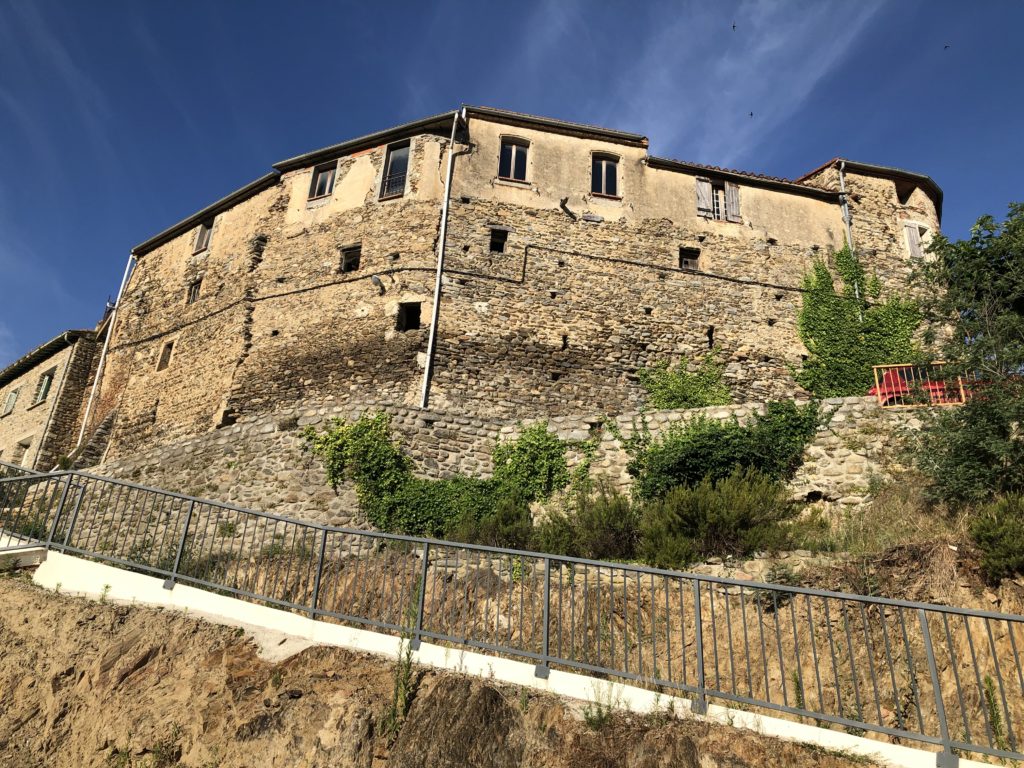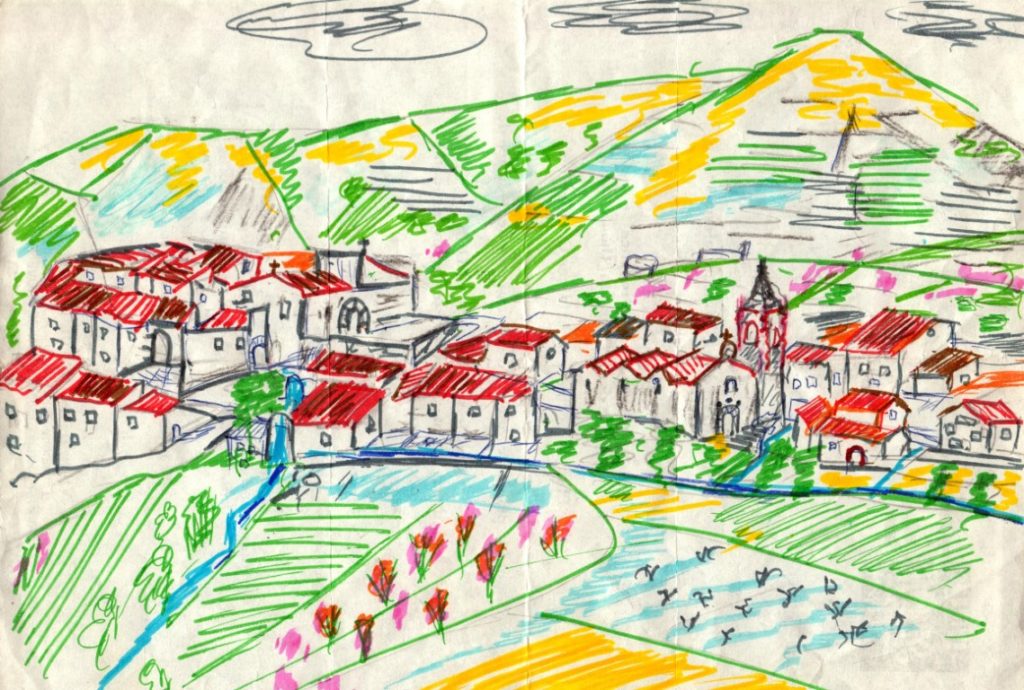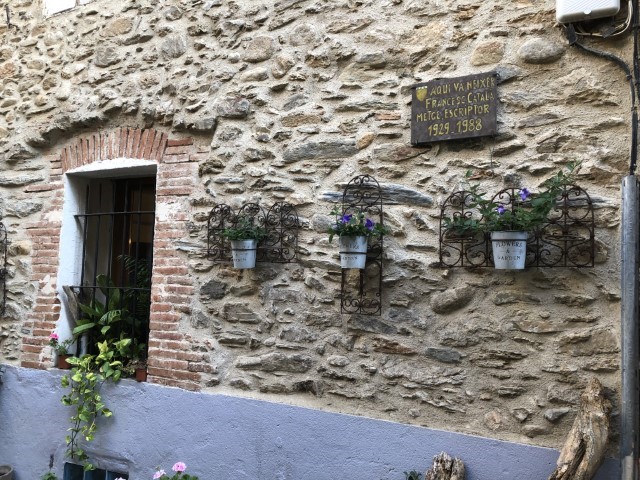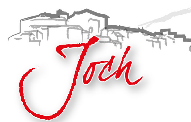
Introduction
The history of Joch has evolved around its castle, which was already mentioned in the 11th century.
Thanks to its fortifications, Joch was acknowledged for six centuries as the chief town of the « barony », that is to say the territory covering the whole area of the plain below. Now there are just some ruins of that castle. Only two medieval entrances to the north and to the west are still present.Then, the remnants of the ancient chapel have been renovated and turned into a private dwelling.
The village church dates from 1776. Its remarkable altarpieces enrich Joch’s patrimony together with the painted ceiling dating from the seventeenth century which was uncovered in the old rectory while it was being restored. It represents a vernacular patrimony bearing witness of an ancestral way of life.
Let’s retrace now the broad outlines of the history of Joch.
The origins
Before the Romans came to this area ( called le Conflent) it was inhabited by people called the Ceretes. Some historians think that the name of Joch comes from the language of these people, more precisely from the word « diuko », meaning « a place which exhausts oxen », obviously alluding to the steep slopes of the village ! Others think that the name of the village comes from the celt « jukk » meaning « hill » or « high place ».
During Roman occupation
A Roman road called the « strada confluentana » which joined Roussillon to Cerdagne crossed the plain below Joch. There is now a byroad which is part of the northern limit of Joch ; it is called « cami de l’ Estrada »…(probably the same origin as la strada) ?
We may presume that the Romans built a military post in Joch on top of the steep hill ( where the castle is now ) in order to observe the « strada confluentana ».
Joch became the centre of the Vicountcy of Conflent at the time of the Wisigoths who came after the Romans.
The Viscounts of Conflent
These viscounts were in charge of the management of Conflent. We may assume that Joch had already been such a centre during the Roman dominance. We do not know much about those viscounts, we do not even know if they lived in Joch on a regular basis.
One of the first viscounts we read about was called Eldesind. His name was mentioned in 869. Then Viscount Isarn was alluded to from 955 until 968. His son Bernard then his grandson Arnald came after him, but from 1010 on there were no specific viscounts ruling the Conflent.
The Viscounts of Cerdagne and their successors
Arnald, being without an heir, may have given up his rights to his sister, who had married Seniofred, the Viscount of Cerdagne. So their son Bernard became the Viscount of Cerdagne and Conflent.
In 1035 Bernard took oath of allegiance to his lord, the Earl of Cerdagne, for the castle of Joch. It is the first written mention of Joch.
Those viscounts soon disappeared and in the twelfth century the seigneury of Joch belonged to two families : The Urg family and the Castellbo family. However , the Counts of Cerdagne, then their heirs the Counts of Barcelona, and after them the Kings of Aragon kept the right of high counsel on the Seigneury of Joch.
The Urg family
The members of the Castellbo family, who were close to the Cathars, did not play a major part in the history of Joch. On the contrary, the Urg family made some very meaningful decisions.
For example, in 1173, The King of Aragon gave the inhabitants of the three villages of the Barony ( Joch, Finestret, Saorla) as well as the inhabitants of Vinça, Rigarda and Vilella, the right to catch the waters of the river Lentilla and to build a canal in order to irrigate their fields in the plain below Joch.
Sixteen years later, in 1298, Gueralda d’ Urg’s cousin , Pierre de Fenollet, became the new owner of Joch’ s Seigneury. The canal was not completed yet for lack of funds. After long negotiations between the noble man and the villagers, the building of the canal was resumed in 1301 and the year after, the waters of the river Lentilla reached Joch.
In April 1302, the inhabitants of the Barony acknowledged that they had to take their grains to the water mills owned by their Lord Pierre de Fenouillet. Those water mills were located near the water falls ( at the place called « el salt »)
The Perellos family
Ramon de Perellos became the only Lord of Joch in 1357 after marrying the heiress of the Castellbo family and after buying the second half of Joch’s seigneury from André de Fenollet. Later on, in 1365, he bought from the King of Aragon the rights of high counsel in the Barony. He decided to have new fortifications built around the village ( called « la Força » or « la Fortsa » ) in order to protect the inhabitants from the « grandes compagnies », hords of mercenaries coming from France, who plundered and ruined the villages of Conflent. The building of « la Força » lasted for seven years ( from 1361 to 1368). These fortifications can still be seen nowadays.
Ramon de Perellos’ s daughter, was called Eleonore, she was known as « la dame de Joch » ( the lady of Joch ) because she succeeded her father in 1384 and remained in power until she died , over sixty years later ( in 1459). Around 1440, she succeeded in making the barony much wider after acquiring the villages of Rigarda, Glorianes and Sahilla. She had married twice but she did not have any children, so her nephew Bernard de Perepertusa inherited her possessions and came to live in the castle of Joch.
The Perapertusa family
They made Joch their main place of residence for over two centuries ( until the 1650s). That is why the village has kept their armorial bearings as coat of arms for Joch : three diamonds on a golden shield.
The Barons of Joch belonging to the Perapertusa family were :
Gaston de Perapertusa. He was Bernard’s grandson and wrote his will in the castle of Joch on February 25th 1505. His wish was to be buried in the parish church.
His son, François de Perapertusa, became one of the most powerful lords of the area. Apart from the barony of Joch, he owned various places in Fenouilledes( Prats, Sequera, Trevillac, Rabollet…) and he also acquired the seigneury of Rodes in 1543.
Antoine de Perapertusa succeeded him around 1554 and died in 1583.
His son Jacques succeeded him, but he caught the plague in Barcelona during the summer of 1591 and died there in September of the same year.
His brother Pierre de Perapertusa succeeded him. He is still the most famous of the barons of Joch. He was born and baptized in Joch in January 1573. After becoming Seigneur/ Lord of Joch,and with the help of his vassals, he expelled from Vinça five or six hundred French Lutherans who had besieged the town and had started plundering . In 1600 the King of Spain rewarded Pierre de Perapertusa with the title of Viscount of Joch. To celebrate this big event, the new viscount allowed the inhabitants of Joch to derive benefits from the rights of measuring, of opening cafés, restaurants and inns, as well as bakeries and « charcuteries » ( delicatessen). Pierre de Perapertusa probably died in Barcelona around 1624 but his body was taken to Joch only nine years later on May 20th 1635 and buried in the parish church next to his parents in the family vault at the foot of the altar of the Virgin Mary.
Pierre’s son Antoine de Perapertusa, became the second viscount of Joch. Many documents from 1624 to 1652 mention his name. He lived in the castle with his family and servants. He sometimes went to Spain, more precisely to Barcelona where he owned considerable possessions. In 1651 he had the chapel of the castle (dedicated to St Peter and St Paul) enlarged. Now this chapel has become a private dwelling. Only its portal has remained almost untouched.
When Roussillon became French, in 1659 , with the treaty of the Pyrenees, the viscounts of Joch left Conflent for good to settle in Barcelona, the Catalan capital.
From the treaty of the Pyrenees to the French revolution
Antoine de Perapertusa died in1676. His heirs became estranged from Joch. Yet they were still the Seigneurs/ Lords of Joch ; their procurators represented them .
In 1756, Countess D’ Aranda, the viscountess of Joch, the heiress of the Perapertusa family, agreed to give her financial help to the community of Joch in order to build a new church.
Her son, Count d’Aranda,was one of Spain’s grandees, and Voltaire’s friend . He was the last viscount of Joch. In 1776 he gave the community six hundred « livres » to finish the construction of the new church.
The time of the Revolution
François Molins belonged to one of the wealthiest families of the village.( the Molins’s family dwelling can still be seen inside the « Força ». The date 1623 is engraved on its portal) François was a priest, but he soon became a fervent supporter of the new ideas brought about by the French revolution. He wrote about « the hateful rights of the old regime which drove the people to make a revolution fortunately leading to freedom »
In 1792, unlike most of the members of the clergy in the region, he took oath of allegiance to the nation and the constitution adopted by the Assemblée Nationale. Moreover he became mayor of Joch in 1798 while still being the parish priest ! But in 1802 he had to make a choice. He decided to remain Mayor of Joch and was reelected until 1816. When the possessions of the clergy were sold, he bought the old rectory ( which is the current townhall) and made it its home.
In the early nineteenth century the castle and its outbuildings were also sold to several inhabitants of the village after being divided into many portions.
The nineteenth and twentieth centuries
The current belltower was built in 1867. The bells and the clock were delivered in 1870.
During the nineteenth century the main problem in Joch was the education of children. The first school was located next to the church, in a room much too small to accommodate all the children. This room can still be seen in the Carrer Major next to the church.

So, in 1880 it was decided to build a new school. The construction lasted for two years , and in 1882 the school of Joch opened its doors to 56 pupils : 29 girls and 27 boys.
As the population of the village diminished during the twentieth century, the village school closed its doors in 1967.
This demographic decline started as soon as the first world war, when twenty- two young men from the village were killed. After the war, a monument « aux morts » was erected near the school to pay a tribute to them.There were up to 320 inhabitants in Joch in the middle of the nineteenth century. Then there were fewer and fewer people with a minimum of 120 in the early eighties.
Joch today
There have been deep changes over the past twenty years. The farming areas used to be mainly orchards, they have diversified and many of them are now fodder crops. Besides, new housing developments are spreading along the « traverse de Vinça » and to the north of Mas Roubi. They appeal to new residents who are attracted by country life and a beautiful countryside. More and more people settle in Joch. There are now 400 inhabitants .

Francis Catala ( 1929- 1988) was a general practitioner and a Catalan poet (you can see a photo of Francis Catala’s native house)
Més enllà del mar m’espera, Conflent, en un corn de món ;
« beyond the sea, Conflent is expecting me, a little place in the world ;
Més enllà del mar, ma terra amb el sol que hi riu damunt.
beyond the sea, my land with the sun smiling above. »
Francis Català, Camins
Texte : Jean-Claude GRAULE
Traduction : Thérèse TRABIS-GURRERA
